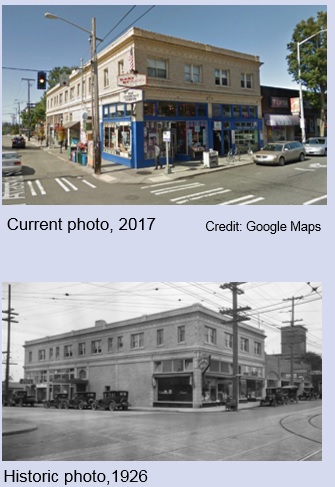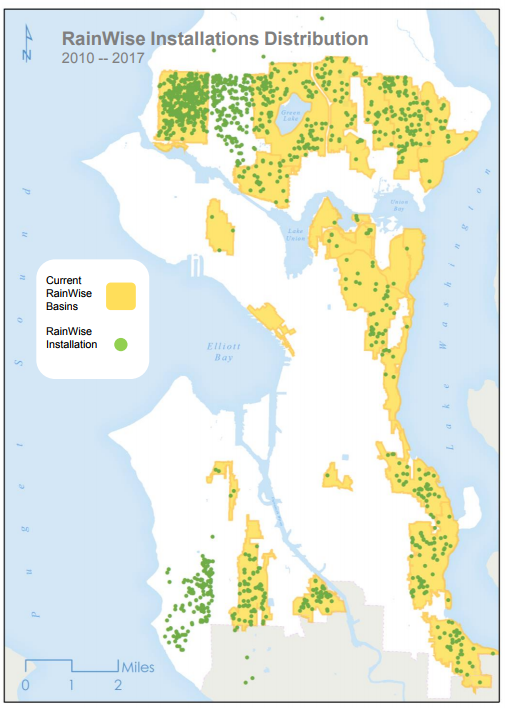Crescent-Hamm Building Historic Preservation; Stormwater Investments Coming for Longfellow Creek; MHA Committee Established
Crescent-Hamm Building Historic Preservation
 As Seattle grows, it’s critically important to maintain connections to our past. Seattle’s Historic Preservation program, in effect since 1973, has designated more than 450 sites as landmarks, helping us to preserve our heritage.
As Seattle grows, it’s critically important to maintain connections to our past. Seattle’s Historic Preservation program, in effect since 1973, has designated more than 450 sites as landmarks, helping us to preserve our heritage.
On Monday, the Full Council will vote to complete the landmark designation process for the Crescent-Hamm Building in the Alaska Junction. The Finance and Neighborhoods Committee voted to approve the legislation earlier this week.
The Crescent-Hamm Building was completed in 1926, and is located on the northwest corner of Alaska and California. It’s the location of Easy Street Records and other businesses.
The Landmarks Preservation Board earlier approved the designation as a historic landmark in February 2017 and found that it met three of the six criteria for landmark status (only one is needed for landmark status):
- It is associated in a significant way with a significant aspect of the cultural, political, or economic heritage of the community, City, state or nation;
- It embodies the distinctive visible characteristics of an architectural style, or period, or of a method of construction;
- Because of its prominence of spatial location, contrasts of siting, age, or scale, it is an easily identifiable visual feature of its neighborhood or the City and contributes to the distinctive quality or identity of such neighborhood or the City.
The Council’s vote will impose controls on the exterior of the building, the final step in the landmarks process. Here’s a link to the report of the Landmarks Preservation Board.
The Council earlier voted to approve landmark status for the Campbell Building in December, across the street. Both nominations came thanks to the work of the Southwest Seattle Historical Study Group, a collaboration of the SW Seattle Historical Society, SW District Council, West Seattle Junction Association, the Junction Association (JuNO), and ArtsWest.
Many thanks to all of them for their work to help preserve our heritage in West Seattle!
Green Stormwater Infrastructure Program Investments for Longfellow Creek Coming
Green stormwater infrastructure helps capture and clean polluted water runoff from roads, roofs, parking lots and other sources. When it rains, water picks up oil, greases, metal and other pollution as it makes its way back to our rivers, lakes and ultimately the Puget Sound. This pollution is toxic to the wildlife in our streams. As such, in 2013, the Council and Mayor directed departments to work together to manage a goal of 700 million gallons of stormwater runoff using green infrastructure, this is part of the Consent Decree we entered into with the Environmental Protection Agency (EPA) and the State Department of Ecology to reduce sewer overflows into Seattle’s water bodies. Seattle Public Utilities (SPU) had initially allocated $30 million to this end. However, during last year’s Strategic Business Plan update the Council approved an additional $35 million over the next six-years.
The Utility is tackling this issue in a number of ways. Many of you may have seen signs around your neighborhood for the RainWise program. This program, for eligible customers, provides a possible rebate of up to $5,000 for the installation of a rain garden or cistern. These solutions clean the water before it carries the pollutants to our waterways preventing the toxins from harming our wildlife. If you’re interested in the program and would like to see if you’re eligible, please go here.
In addition to the smaller scale RainWise program, SPU is partnering with sister agencies to lower costs and install “bioretention” along many of our street blocks within Seattle’s three major watersheds: Longfellow Creek, Thornton Creek, and Pipers Creek. Specifically, Longfellow Creek will begin the design phase of these bioretention areas this year and construction is set to begin in 2019.
Finally, SPU is working to leverage redevelopment to lower costs while updating green infrastructure. They are working with the Office of Planning and Community Development to prioritize urban villages based on equity, growth, and density to improve drainage, water quality and livability in the most rapidly growing areas. While I am supportive of this partnership and the outcomes, it is important to note that SPU recognizes that these types of improvements, by making these communities more livable and desirable to higher -income individuals, have the potential to exacerbate displacement of low-income individuals and communities of color. We need to ensure that we couple these investments with citywide anti-displacement strategies.
If you’d like to learn more, you can see SPU’s presentation here, and watch it here.
Select Full Council Committee on MHA Established
On January 22, 2018 Council President Bruce Harrell established the 2018 Select Committee on Citywide Mandatory Housing Affordability (MHA). The committee was formed to begin the next steps to consider implementation of the citywide MHA including changes to land use regulations, zoning designations, comprehensive plan language and maps, neighborhood plan policies and changes to Urban Village boundaries.
The committee will also be considering development standards for all multifamily and commercial areas throughout the city. The Council, in its MHA framework legislation passed in 2016, also signaled its intent to, in July of this year, and before the Council votes on the Citywide MHA zoning legislation, revisit mandatory developer housing affordability obligations that are required for all developments in areas receiving additional building capacity under proposed rezones.
Historic districts and the areas already rezoned will be excluded from these discussions as the rezones in these areas have already been voted on by City Council. The City has completed rezoning in the University District, Downtown, South Lake Union, Chinatown/International District, the 23rd-Union-Jackson Urban Village and the Uptown Urban Village.
The first meeting of the Select Committee on Citywide MHA will be Monday January 29, 2018 in council chambers.
In this initial meeting we will be reviewing a short history of MHA as well as the MHA principles and maps. There will be up to 20 minutes of public comment at the end of the meeting. For more information about District 1 MHA engagement opportunities please see my January 5th post on the issue.
Posted: January 26th, 2018 under Councilmember Herbold, Homelessness, LGBTQ, Libraries, Planning and Land Use, Seattle Public Utliities, Zoning
Tags: Crescent-Hamm, landmarks, Longfellow Creek, Mandatory Housing Affordability, Seattle Public Utilities, stormwater, zoning

